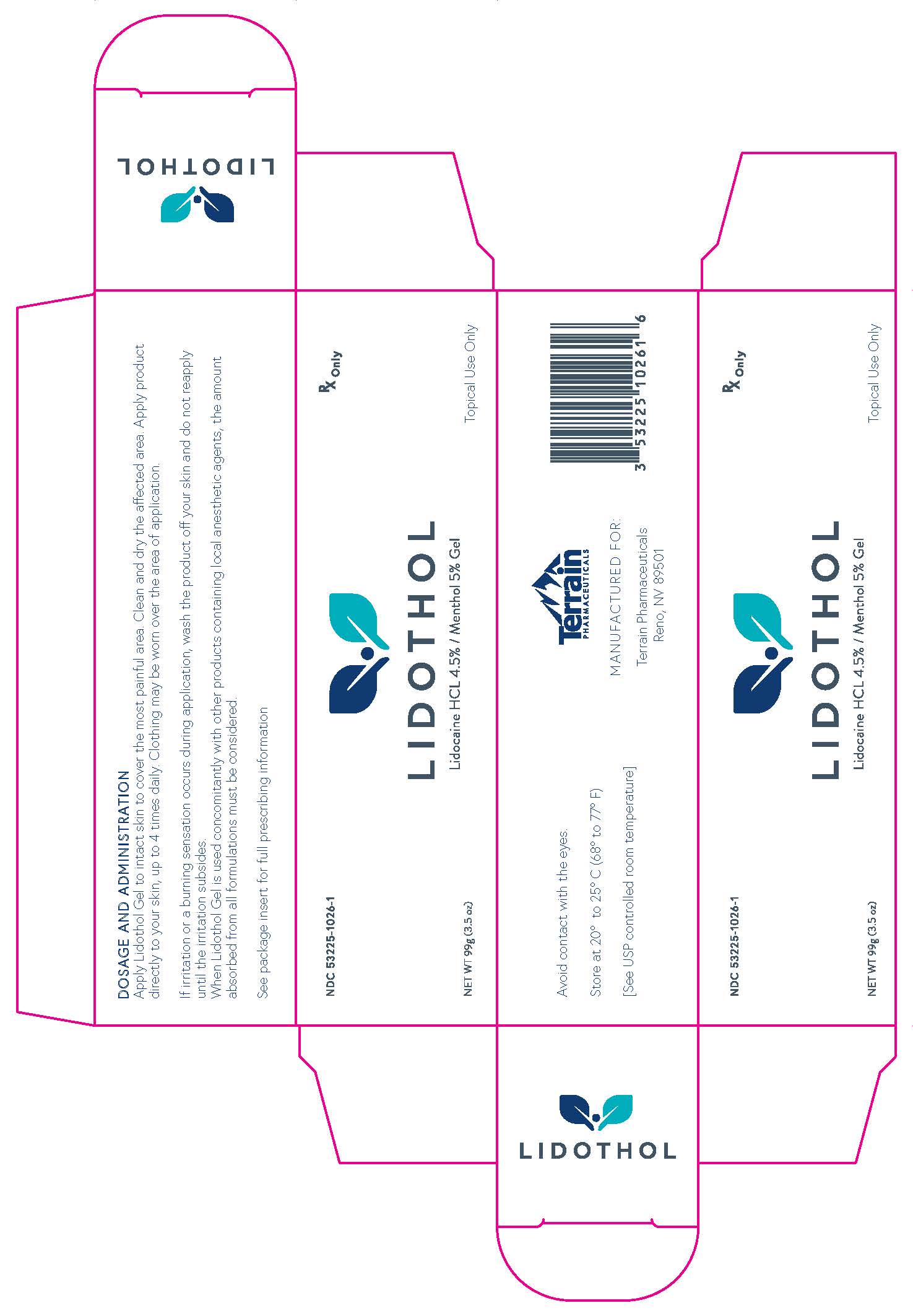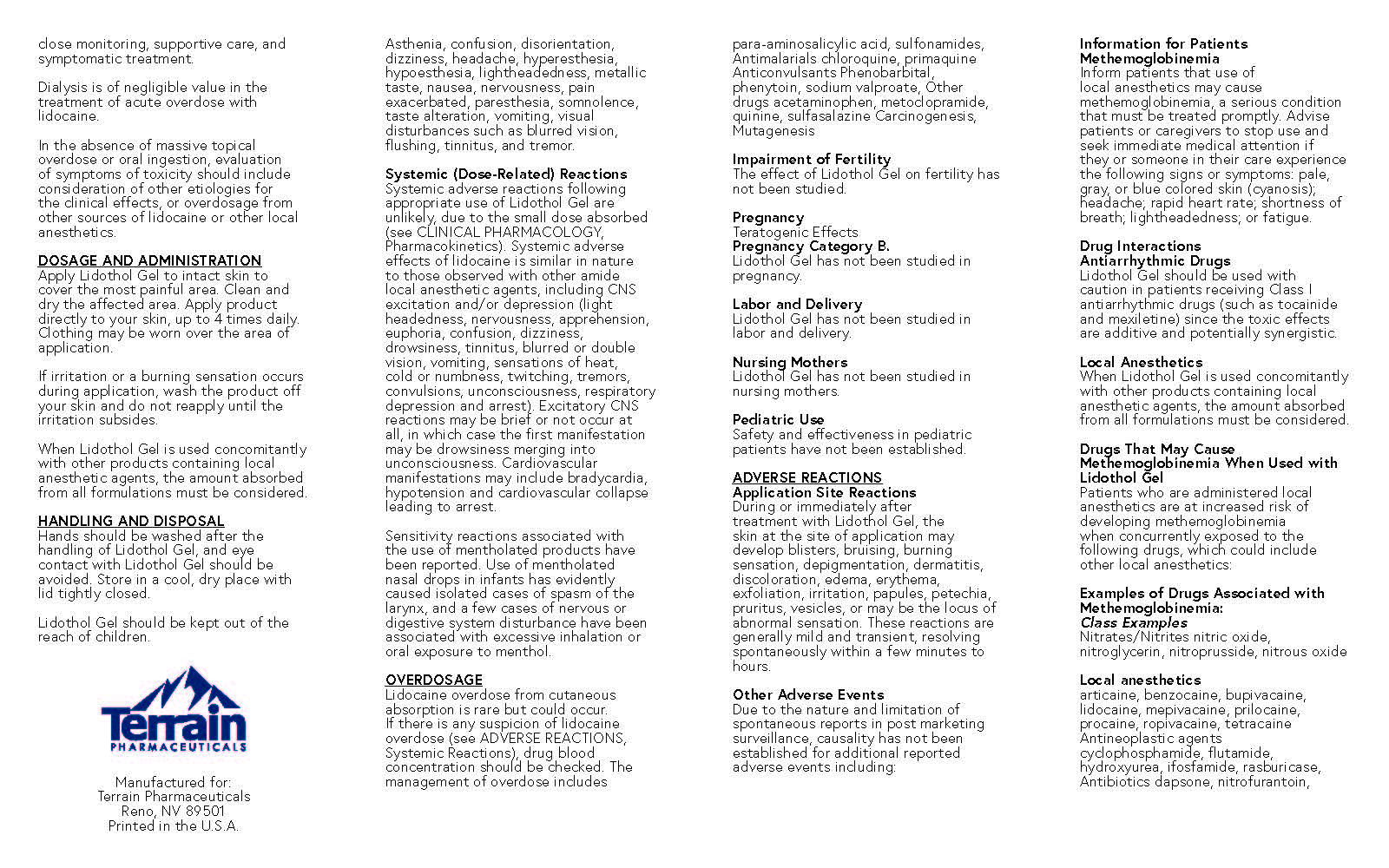DESCRIPTION
Lidothol Gel (Lidocaine 4.5%, Menthol 5%) is comprised of a gel inside of a tube containing 4.5% Lidocaine and 5% Menthol.
Inactive ingredients: Acrylates/C10-30 Alkyl Acrylate Crosspolymer, Arnica Montana Flower Extract, Boswellia Serrata Gum Extract, Butylene Glycol, Dimethyl Sulfone, Ethylhexylglycerin, llex Paraguariensis Leaf Extract, Magnesium Sulfate, Phenoxyethanol, Polysorbate-20, Propylene Glycol, SD Alcohol 40-B, Triethanolamine, Water
CLINICAL PHARMACOLOGY
Pharmacodynamics
Lidocaine is an amide-type local anesthetic agent. The penetration of lidocaine into intact skin after application of Lidothol Gel is sufficient to produce annalgesic effect, but less than the amount necessary to produce a complete sensory block.
Menthol is a covalent organic compound made synthetically or obtained from peppermint or other mint oils. Menthol induces a cooling sensation on the skin upon topical application by stimulating the cold-sensitive receptors expressed on the skin, without actually causing a drop in the skin temperature.
Pharmacokinetics
Absorption
The amount of lidocaine systemically absorbed from Lidothol Gel is directly related to both the duration of application and the surface area over which it is applied.
Menthol occurs in numerous over-the-counter products. Although extensively used, there have been no estimates of human exposure following administration via dermal application.
Distribution
At concentrations produced by application of Lidothol Gel, approximately 70% of the lidocaine dose is reported to be bound to plasma proteins, primarily alpha-1-acid glycoprotein. At higher plasma concentrations (1 to 4 mcg/mL of free base), the plasma protein binding of lidocaine is concentration dependent.
Metabolism
It is not known if Lidothol Gel is metabolized in the skin.
Excretion
Lidocaine and its metabolites are excreted by the kidneys. Less than 10% of lidocaine is excreted unchanged. The half-life of lidocaine elimination from the plasma following IV administration is 81 to 149 minutes (mean 107 ± 22 SD, n = 15). The systemic clearance is 0.33 to 0.90 L/min (mean 0.64 ± 2 max max 0.18 SD, n = 15).
INDICATION AND USAGE
Lidothol Gel is indicated for relief of pain associated with arthritis, backache, cramps, discomfort, neckache, soreness, sprains, strains. It should be applied only to intact skin.
CONTRAINDICATIONS
Lidothol Gel is contraindicated in patients with a known history of sensitivity to local anesthetics of the amide type, or to any other component of the product.
WARNINGS
Medicines intended to be applied to the skin should not be swallowed.
Lidothol Gel is flammable. Keep away from open flame.
You should never heat, microwave, or add the medicine to hot water.
Risk of Methemoglobinemia
Cases of methemoglobinemia have been reported in association with lidocaine use. Although all patients are at risk for methemoglobinemia, patients with glucose-6-phosphate dehydrogenase deficiency, congenital or idiopathic methemoglobinemia, cardiac or pulmonary compromise, infants under 6 months of age, and concurrent exposure to oxidizing agents or their metabolites are more susceptible to developing the condition. If lidocaine must be used in these patients, close monitoring for symptoms and signs of methemoglobinemia is recommended. Signs of methemoglobinemia may occur immediately or may be delayed some hours after exposure, and are characterized by a cyanotic skin discoloration and/or abnormal coloration of the blood.
Methemoglobin levels may continue to rise; therefore, immediate treatment is required to avert more
serious central nervous system and cardiovascular adverse effects, including seizures, coma,
arrhythmias, and death.
Excessive Dosing
Excessive dosing by applying Lidothol Gel to larger areas could result in increased absorption of lidocaine and high blood concentrations, leading to serious adverse effects (see ADVERSE REACTIONS, Systemic Reactions). Lidocaine toxicity could be expected at lidocaine blood concentrations above 5 mcg/mL. The blood concentration of lidocaine is determined by the rate of systemic absorption and elimination. Longer duration of application of more than the recommended number of doses, smaller patients, or impaired elimination may all contribute to increased blood concentration of lidocaine.
PRECAUTIONS
General
Hepatic Disease
Patients with severe hepatic disease are at greater risk of developing toxic blood concentrations of
Lidocaine and menthol, because of their inability to metabolize lidocaine and menthol normally.
Allergic Reactions
Patients allergic to para-aminobenzoic acid derivatives (procaine, tetracaine, benzocaine, etc.) have not
shown cross sensitivity to lidocaine. However, Lidothol Gel should be used with caution in patients
with a history of drug sensitivities, especially if the etiologic agent is uncertain.
Although rare, get emergency medical help if you have signs of an allergic reaction from oral or topical application of menthol: hives, difficulty breathing, or swelling of your face, lips, tongue, or throat.
Non-intact Skin
Application to broken or inflamed skin, although not tested, may result in higher blood concentrations of lidocaine and menthol from increased absorption. Lidothol Gel is only recommended for use on intact skin.
External Heat Sources
Placement of external heat sources, such as heating pads or electric blankets, over Lidothol Gel
is not recommended as this has not been evaluated and may increase plasma lidocaine levels.
Eye Exposure
The contact of Lidothol Gel with eyes, although not studied, should be avoided based on the findings of
severe eye irritation with the use of similar products in animals. If eye contact occurs, immediately
wash out the eye with water or saline and protect the eye until sensation returns.
Information for Patients
Methemoglobinemia
Inform patients that use of local anesthetics may cause methemoglobinemia, a serious condition that must be treated promptly. Advise patients or caregivers to stop use and seek immediate medical attention if they or someone in their care experience the following signs or symptoms: pale, gray, or blue colored skin (cyanosis); headache; rapid heart rate; shortness of breath; lightheadedness; or fatigue.
Drug Interactions
Antiarrhythmic Drugs
Lidothol Gel should be used with caution in patients receiving Class I antiarrhythmic drugs (such as
tocainide and mexiletine) since the toxic effects are additive and potentially synergistic.
Local Anesthetics
When Lidothol Gel is used concomitantly with other products containing local anesthetic agents, the
amount absorbed from all formulations must be considered.
Drugs That May Cause Methemoglobinemia When Used with Lidothol Gel
Patients who are administered local anesthetics are at increased risk of developing methemoglobinemia
when concurrently exposed to the following drugs, which could include other local anesthetics:
Examples of Drugs Associated with Methemoglobinemia:
Class Examples
Nitrates/Nitrites nitric oxide, nitroglycerin, nitroprusside, nitrous oxide
Local anesthetics
articaine, benzocaine, bupivacaine, lidocaine, mepivacaine, prilocaine, procaine, ropivacaine, tetracaine
Antineoplastic agents cyclophosphamide, flutamide, hydroxyurea, ifosfamide, rasburicase, Antibiotics dapsone, nitrofurantoin, para-aminosalicylic acid, sulfonamides, Antimalarials chloroquine, primaquine Anticonvulsants Phenobarbital, phenytoin, sodium valproate, Other drugs acetaminophen, metoclopramide, quinine, sulfasalazine Carcinogenesis, Mutagenesis
Impairment of Fertility
The effect of Lidothol Gel on fertility has not been studied.
Pregnancy
Teratogenic Effects
Pregnancy Category B.
Lidothol Gel has not been studied in pregnancy.
Labor and Delivery
Lidothol Gel has not been studied in labor and delivery.
Nursing Mothers
Lidothol Gel has not been studied in nursing mothers.
Pediatric Use
Safety and effectiveness in pediatric patients have not been established.
ADVERSE REACTIONS
Application Site Reactions
During or immediately after treatment with Lidothol Gel, the skin at the site of application may develop blisters, bruising, burning sensation, depigmentation, dermatitis, discoloration, edema, erythema, exfoliation, irritation, papules, petechia, pruritus, vesicles, or may be the locus of abnormal sensation. These reactions are generally mild and transient, resolving spontaneously within a few minutes to hours.
Other Adverse Events
Due to the nature and limitation of spontaneous reports in post marketing surveillance, causality has not
been established for additional reported adverse events including:
Asthenia, confusion, disorientation, dizziness, headache, hyperesthesia, hypoesthesia, lightheadedness,
metallic taste, nausea, nervousness, pain exacerbated, paresthesia, somnolence, taste alteration,
vomiting, visual disturbances such as blurred vision, flushing, tinnitus, and tremor.
Systemic (Dose-Related) Reactions
Systemic adverse reactions following appropriate use of Lidothol Gel are unlikely, due to the small
dose absorbed (see CLINICAL PHARMACOLOGY, Pharmacokinetics). Systemic adverse effects of
lidocaine is similar in nature to those observed with other amide local anesthetic agents, including
CNS excitation and/or depression (light headedness, nervousness, apprehension, euphoria, confusion,
dizziness, drowsiness, tinnitus, blurred or double vision, vomiting, sensations of heat, cold or numbness,
twitching, tremors, convulsions, unconsciousness, respiratory depression and arrest). Excitatory CNS
reactions may be brief or not occur at all, in which case the first manifestation may be drowsiness
merging into unconsciousness. Cardiovascular manifestations may include bradycardia, hypotension and
cardiovascular collapse leading to arrest.
Sensitivity reactions associated with the use of mentholated products have been reported. Use of mentholated nasal drops in infants has evidently caused isolated cases of spasm of the larynx, and a few cases of nervous or digestive system disturbance have been associated with excessive inhalation or oral exposure to menthol
OVERDOSAGE
Lidocaine overdose from cutaneous absorption is rare but could occur. If there is any suspicion of
lidocaine overdose (see ADVERSE REACTIONS, Systemic Reactions), drug blood concentration
should be checked. The management of overdose includes close monitoring, supportive care, and
symptomatic treatment. Dialysis is of negligible value in the treatment of acute overdose with lidocaine.
In the absence of massive topical overdose or oral ingestion, evaluation of symptoms of toxicity should
include consideration of other etiologies for the clinical effects, or overdosage from other sources of
lidocaine or other local anesthetics.
DOSAGE AND ADMINISTRATION
Apply Lidothol Gel to intact skin to cover the most painful area. Clean and dry the affected area. Apply product directly to your skin, up to 4 times daily. Clothing may be worn over the area of application.
If irritation or a burning sensation occurs during application, wash the product off your skin and do not reapply until the irritation subsides.
When Lidothol Gel is used concomitantly with other products containing local anesthetic agents, the
amount absorbed from all formulations must be considered.
HANDLING AND DISPOSAL
Hands should be washed after the handling of Lidothol Gel, and eye contact with Lidothol Gel should
be avoided. Store in a cool, dry place with lid tightly closed.
Lidothol Gel should be kept out of the reach of children.
HOW SUPPLIED
Lidothol Gel is available as the following:
1 tube, 3.5oz
NDC 53225-1026-1
Store at 25°C (77°F); excursions permitted to 15°-30°C (59°-86°F). [See USP Controlled Room Temperature].
For more information, contact Terrain Pharmaceuticals. info@terrainrx.com
Manufactured for:
Terrain Pharmaceuticals
Reno, NV 89501
Printed in the U.S.A.


